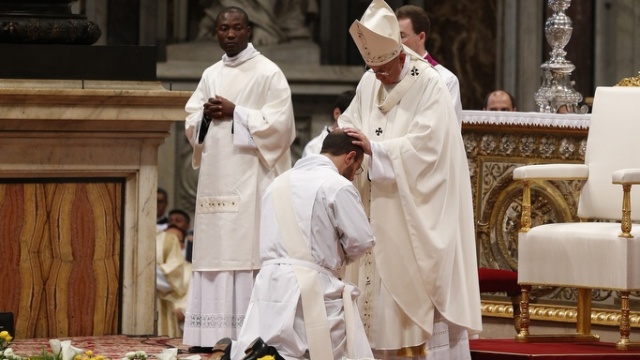Deacon-structing Ordination | Part 1
Deacon Pedro
Sunday, May 22, 2016

It seems appropriate that as we are delving into this topic of Holy Orders, it’s the time of the year when many men are being ordained to the diaconate and the priesthood. Perhaps we should begin by keeping them in our prayers.Today I’d like to focus on some of the basics (very basic, so I apologize if it seems simplistic) of the Sacrament of Holy Orders and it’s good to be reminded at first, that we are not just talking about priests. There are three Orders: bishops, priests and deacons. This goes back to the Acts of the Apostles. When Jesus sent his 12 apostles to go to the ends of the earth and make disciples of all nations (Mt. 28:16-20), they took him seriously (we wouldn't be in the Church today if it wasn't for that): They went and made disciples everywhere. As groups of people became Christian, churches were created and elders were put in place (often with the laying on of hands) to shepherd these churches since the Apostles couldn't be everywhere. As these churches grew in size and in region, the apostles began appointing a supervisor of the elders. This person was usually appointed by one of the apostles (again with the laying on of hands) when they visited the various churches. The supervisor was called the Episkopos which means overseer, in Greek. (We know that St. Paul writes to Timothy and Titus. They were both “overseers”.) The episkopoi, or overseers, became what today we call bishops. As the churches continued to grow the overseers also couldn't be everywhere and they had priests representing them in various churches (in fact, some historians will say that these original Episcopal representatives were deacons). The word priest comes from the Greek word Presbyteroi, which was the word used for elder. (The word in Latin is sacerdos.) There were also other ordained ministers known as diakonoi. They existed even before there were elders. The word diakonoi literally means server (as in the ones who served the food). The appointment (ordination) of the first deacons appears in Acts 6:1-6. These seven men were ordained to beg for food for the Greek-speaking Jewish widows, who in those days, they were the most marginalised group, because the Apostles didn’t have time to do that work. Two famous Acts of the Apostles deacons are Philip and Stephen. Deacons originally had a very specific function in the Church, which was separate from the priesthood, serving the most marginalised. As things evolved, slowly the diaconate disappeared as a separate ministry and became merely a step toward the priesthood (which is why today, all priests are first ordained to the transitional diaconate. This is very, very basic, but we will look at the history of the diaconate later in this series.) The permanent diaconate as it existed in the first couple of centuries was renewed by the Second Vatican Council and so now many dioceses have married men (like me) who are ordained as Permanent Deacons. (Note: the diaconate was renewed not because there was shortage of priests, but because there was a shortage of deacons. The Church needs both priests and deacons!) In the first centuries, in addition to bishops, presbyters and deacons (major orders), there were also other ministers in the Church who were not ordained. We call them “minor orders”. These included: • Subdeacons, who helped the deacons with their duties • Exorcists, who assisted at rituals of initiation and repentance • Lectors, who read the scriptures during worship • Porters, who had janitorial and guard duties and • Acolytes, who accompanied the bishops and acted as secretaries and messengers. (Many of these still exist in the Eastern Churches.) As priests began to perform many of these functions, these orders also began to disappear as separate from the priesthood. Most have still not been renewed. Although, still today, before ordination to the diaconate, all candidates are installed as Lectors and Acolytes. And we know that all priests are first ordained as deacons (and all bishops are first priests). This is probably not the best way to approach the subject, because Holy Orders is not about function, but sometimes it’s easier to understand something when we look at the function. (I do hope, as we get deeper into this that you understand Holy Orders not merely as something functional but something theological.) The reason why the Apostles ordained deacons was so they (the Apostles) could “devote themselves to prayer and to serving the Word.” (Acts 6:4) The deacons then dedicated themselves to the work of charity. In a way, today that is still the case. The priest’s primary function is to administer the Sacraments. I had a priest once tell me that his job was to bring God to the people and bring the people to God. This is a perfect way to look at it since that is what the Sacraments do. If we go way back to look at where our whole tradition of priesthood originates from, the Old Testament, we'll see that this is also what the Jewish priests did. They didn't have Sacraments, but they were mediators between God and the people. God’s chosen people, the people of Israel was considered a “Kingdom of Priests and a Holy Nation”, but within the people of Israel God chose one of the twelve tribes, the Tribe of Levi (which was the tribe Moses and Aaron belonged to), and set it apart for liturgical service. God said to Moses: “Consecrate your brother Aaron and his sons Nadab, Abihu, Eleazer and Ithamar, to be priests, to minister to me.” (See Exodus 28:1 and 30:30. For the first ever consecration or ordination of priests, look at Exodus 29) Part of their job was to take care of the Tabernacle, the Holy place where they kept the Arc of the Covenant, which contained the Tablets of the 10 Commandments. The Tabernacle is where the Holy of Holies was. That is where God was present. The priest’s job was to act on behalf of the people in relation to God, to offer gifts and sacrifices for sins. When Jesus came, He became the ultimate Priest, who offered the ultimate Sacrifice. So, we see Aaron’s priesthood as the priesthood of the Old Covenant and Jesus is the Priest and only Priest of the New Covenant. All priests today (and for the last 2000 years) participate in this one Priesthood of Jesus Christ. But as we said earlier, we’re not just talking about priests: There are three Orders: The bishop represents the fullness of Christ for the Church. The priest shares in the bishop’s office; these two constitute the ministerial priesthood. The deacon is ordained to the ministry of service, not to the priesthood of Christ. In the past when I've deacon-structed Sacraments (and we did this in our show In Your Faith. To understand Sacraments better, check out all our episodes in Season 2 on the seven Sacraments.), I've looked at what I call the “metaphysical occurrence” that takes place. With every Sacrament something that is more than physical takes place – every Sacrament effects a change and this change is not just spiritual but also physical; it is metaphysical. For example, with the Eucharist, the bread and wine become the body, blood, soul and divinity of Christ; with Marriage, the couple becomes one flesh; in Reconciliation, our sins are wiped clean. With Holy Orders there is also a metaphysical occurrence that takes place. In simple terms, the ordained person becomes the person of Christ (Persona Christi Capitis), when he administers the Sacraments. But every Sacrament also mirrors how Christ is a Sacrament of God to the Church. In Holy Orders, Christ is ministering to our religious needs. That’s what priests, deacons and bishops do – just as Christ did. And the Sacrament of Holy Orders represents Christ the Servant, and Christ the Sacrifice and Priest. And if you remember your catechism, a Sacrament is a visible sign of an invisible Grace so every Sacrament confers Grace. In Holy Orders, the ordained minister receives the grace to be a servant, to offer sacrifice and the grace of being the person of Christ. Next week we’ll go a bit deeper into the Sacrament of Holy Orders.
To read all about the Sacraments, you don't need to go further than this blog site: Sacraments Part 1 and Part 2. Part 3 Baptism: Part 1, Part 2 and Part 3. Reconciliation Part 1, Part 2 and Part 3 Eucharist: Part 1, Part 2, Part 3 and Part 4. Confirmation: Part 1, Part 2, Part 3, Part 4 and Part 5. Marriage: Part 1, Part 2, Part 3, Part 4, Part 5, Part 6, Part 7, Part 8, Part 9 and Part 10. Ordination: Part 1, Part 2. Anointing of the Sick: Part 1, Part 2, Part 3

Related Articles:
Category: Deacon-structing, Featured
Tag: Adam and Eve, Exaltation of the Cross, Garden of Eden, Harry Potter, Jesus, Mysteries, Mystery of the Cross, Sins, St. Paul, Triumph of the Cross
Deacon-structing: Electing a Pope
Monday, May 5, 2025
 Deacon Pedro
Deacon Pedro
Deacon Pedro explores the ins and outs of a modern Conclave, and asks, "Where is the Holy Spirit in all this?"
Visit local pilgrimage sites this Jubilee Year
Thursday, January 30, 2025
 Maria Montemayor
Maria Montemayor
For the Jubilee of Hope, there are designated local pilgrimage sites in every country, and Canada is no exception. How is a local pilgrimage site determined? The local bishop can designate any parish, shrine, or basilica in his territory as a Jubilee Year pilgrimage site.
Creating Catholic streetwear
Thursday, January 9, 2025
 Maria Montemayor
Maria Montemayor
Fashion and clothing designed to draw people closer to God can inspire and even sanctify others. Nate Nagello, the CEO and owner of the Toronto-based Sanctified Collective, hopes the clothing he creates can provide opportunities for conversation, engagement, and evangelization.
When do you pray the Rosary?
Wednesday, December 4, 2024
 Maria Montemayor
Maria Montemayor
The Rosary is powerful: many graces can be bestowed upon those who pray it, and it can also offer special protection. Reciting the Rosary aloud in church and praying for the pope’s intentions can grant the supplicant a plenary indulgence.
Deacon-structing: What is a Heresy?
Tuesday, November 12, 2024
 Deacon Pedro
Deacon Pedro
What is the difference between heresy and simple disagreement? Looking at some of the main heresies throughout history might light the way forward.
SUPPORT LABEL
$50
$100
$150
$250
OTHER AMOUNT
DONATE













